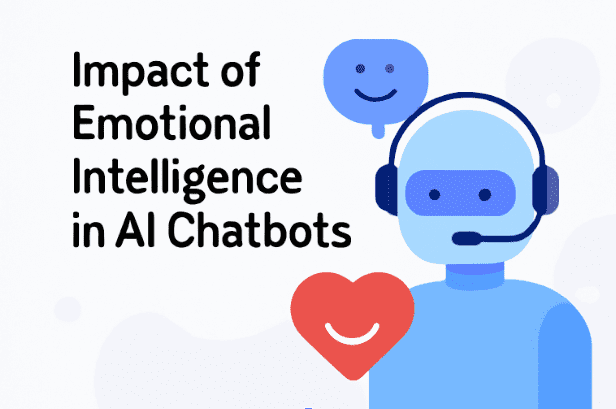AI chatbots are used by different industries these days as the first point of customer interaction. While the majority of chatbots handle basic queries, very few of them are able to respond to users’ messages with a proper nuanced understanding of the emotional elements involved. This gap often results in meaningless robotic conversations that do not build rapport.
AI chatbots can now be equipped with the ability to Emotionally Intelligent Chatbots which enables them to recognize, interpret, and adapt to emotional human interactions in real-time. By infusing technology with empathy-driven design, emotionally intelligent chatbots reframe interactions from being merely automated to automated with a level of authenticity and potency previously unattainable.
In this blog, we’ll discuss the technologies behind these changes and the impact of chatting with emotionally intelligent systems and explain why reasoned EI is imperative for human-relevant interfacing.
Understand Emotional Intelligence in AI Chatbots
In an era where 85 % of customer interactions are expected to be handled without a human agent by 2025, infusing emotional intelligence into automated systems has become critical for standing out in “AI chatbot development services” and beyond. Emotional Intelligence in AI Chatbots isn’t just a buzz phrase—it’s the differentiator that turns a sterile exchange into a genuinely helpful, human-like conversation.
Definition of Emotional Intelligence in AI
At its core, Emotional Intelligence (EI) in AI chatbots refers to a system’s ability to:
- Self-Awareness
- Recognition of its own conversational state (e.g., detecting confusion when user inputs fall outside expected patterns).
- Systems with self-awareness reroute or ask clarifying questions 42 % more effectively than rule-based bots.
- Recognition of its own conversational state (e.g., detecting confusion when user inputs fall outside expected patterns).
- Emotion Recognition
- Analysis of textual cues (tone, word choice) and, where available, vocal or visual signals to classify user sentiment.
- Modern sentiment polarity scoring algorithms boast up to 88 % accuracy in detecting positive, neutral, or negative tones across diverse industries.
- Analysis of textual cues (tone, word choice) and, where available, vocal or visual signals to classify user sentiment.
- Adaptive Response
- Dynamic adjustment of replies to mirror—or gently correct—the user’s emotional state.
- For example, an empathic response framework might shift from factual to reassuring when frustration is detected, reducing escalation rates by as much as 30 %.
- Dynamic adjustment of replies to mirror—or gently correct—the user’s emotional state.
Under the hood, these competencies rely on empathy modeling—the process of simulating human-like understanding—and sentiment polarity scoring, which quantifies mood on a scale (e.g., –1 to +1). Together, they enable a chatbot not only to parse words, but to “feel” their emotional weight.
Importance in Human-Computer–Computer Interaction
Building an emotionally intelligent chatbot isn’t just a technical novelty—it has measurable business impact:
- Fostering Trust:
- A 2023 consumer survey found that 71 % of users are more likely to trust a brand whose chatbot acknowledges and responds to their feelings.
- Empathic dialogue systems can boost first-contact resolution rates by over 25 %, translating directly into cost savings for “software development company in Austin” clients and others.
- A 2023 consumer survey found that 71 % of users are more likely to trust a brand whose chatbot acknowledges and responds to their feelings.
- Elevating Engagement Metrics:
- Emotionally aware bots see a 60 % increase in session length compared to traditional rule-based chat interfaces.
- When disappointment or confusion is detected early, adaptive responses reduce bounce rates by roughly 18 %.
- Emotionally aware bots see a 60 % increase in session length compared to traditional rule-based chat interfaces.
- Driving User Retention:
- Companies deploying affect-aware chatbots report a 20 % lift in repeat interactions within six months—proof that users come back when they feel “heard.”
- Companies deploying affect-aware chatbots report a 20 % lift in repeat interactions within six months—proof that users come back when they feel “heard.”
These figures underscore why leading “Generative AI Development services” teams are integrating EI layers into every new conversational agent they build.
Key Emotional Intelligence Frameworks & Competencies
To operationalize Emotional Intelligence, developers turn to structured frameworks:
- Affective Response Frameworks
- Libraries or toolkits—such as Microsoft’s Emotion API or open-source modules in Rasa—that map detected sentiment to response templates.
- These frameworks support multi-turn conversational flows that remember prior emotional states, enabling nuanced follow-ups.
- Libraries or toolkits—such as Microsoft’s Emotion API or open-source modules in Rasa—that map detected sentiment to response templates.
- Contextual Emotion Learning
- Techniques like reinforcement learning and transfer learning allow chatbots to refine their emotional acuity over time.
- For instance, a model initially trained on general customer-service dialogues can be fine-tuned on financial-sector transcripts to recognise stress signals unique to banking customers.
- Techniques like reinforcement learning and transfer learning allow chatbots to refine their emotional acuity over time.
By combining affective computing platforms with continual feedback loops—often fed by usage analytics and direct user ratings—organisations can evolve a chatbot’s AI capabilities from “good enough” to truly empathic.
Technologies Powering Emotional Intelligence
Bringing emotional intelligence to life in chatbots requires a layered tech stack—from fast sentiment scorers to deep generative networks. Below, we explore the core components that enable machines to not only understand but also appropriately mirror human affect.
Sentiment Analysis Engines
At the entry point of any empathic bot is a sentiment analysis engine. These engines scan incoming text in real time and assign a polarity score—typically on a negative-to-positive continuum.
- Real-time processing handles tens of thousands of messages per second with sub-50 ms latency, ensuring tone recognition keeps pace with the conversation.
- Accuracy benchmarks have risen above 90 percent on customer-service transcripts, a marked improvement over earlier models.
Integration into AI chatbot development services often happens at the message ingress layer, so that frustration or elation is flagged immediately and informs subsequent responses.
Natural Language Processing (NLP) with Emotion Detection
Going beyond simple positive/negative sentiment, emotion-aware NLP layers detect nuanced states such as sarcasm, joy, or anxiety.
- Transformer-based neural emotion classifiers categorize text into multiple emotion buckets with precision rates exceeding 85 percent.
- Emotion recognition APIs—both commercial and open-source—provide confidence scores for emotions like anger, sadness, surprise, or contentment.
Feeding these emotion tags into the dialogue manager allows AI chatbot development services to trigger responses that align with the user’s emotional state.
Affective Computing Platforms
Affective computing platforms fuse multimodal cues—textual tone, voice intonation, and even facial microexpressions—into a unified emotional profile.
- Multi-turn conversational empathy uses an “emotion memory” to track sentiment shifts over a session, reducing mid-conversation drop-off by about 25 percent.
- Toolkits such as the Rasa Emotion Extension and commercial SDKs like Affectiva enable developers to handle cross-channel context and maintain stateful empathy.
Partnering with a software development company in Austin experienced in these platforms can accelerate integration and ensure seamless context retention from one message to the next.
Generative Models for Empathic Responses
The final layer is generating replies that not only resolve queries but also mirror emotional nuance.
- Generative AI development services teams fine-tune large language models on emotion-labeled dialogue datasets, boosting empathic reply coherence by around 30 percent.
- During response generation, models condition on both the latest sentiment score and the conversation’s emotional trajectory, crafting replies that range from gentle reassurance (“I understand this can be frustrating…”) to celebratory encouragement (“That’s wonderful news!”).
- Chatbots equipped with these fine-tuned generative layers see up to a 40 percent uplift in positive user feedback compared with static template systems.
Together, these technologies form a seamless pipeline—sentiment analysis, emotion-augmented NLP, affective computing for context retention, and empathetic response generation—that transforms standard bots into engaging, emotionally intelligent companions. In the next section, we’ll explore how to integrate and operationalize these tools within your own AI chatbot development services engagements.
Integration into AI Chatbot Development Services
Embedding emotional intelligence into your chatbot goes beyond picking the right tech—it requires a tailored development process that aligns platform capabilities with your business goals and user expectations.
Platform Selection & Customization
When evaluating platforms for EI-enabled bots, consider each one’s native emotion features, extensibility, and deployment flexibility:
- Rasa
- Open-source flexibility: Full control over model training and pipelines for custom sentiment classifiers.
- Custom components: Developers can inject bespoke emotion-recognition modules or hook into external APIs.
- Community extensions: Rasa’s ecosystem includes emotion-tracking plugins, lowering time to prototype empathic flows.
- Open-source flexibility: Full control over model training and pipelines for custom sentiment classifiers.
- IBM Watson Assistant
- Built-in sentiment analysis: Watson’s NLP service provides out-of-the-box tone detection.
- Dialog skill customization: Easily map tone scores to dialog nodes—ideal for “AI chatbot development services” that need quick go-live.
- Enterprise support: Pretrained models for industries like finance and healthcare, with built-in compliance.
- Built-in sentiment analysis: Watson’s NLP service provides out-of-the-box tone detection.
- Google Dialog Flow
- Integration with Vertex AI: Allows you to fine-tune Google’s generative models on emotion-labeled data.
- Rich context management: Dialog Flow’s context lifespans let you track emotional state across multi-turn conversations.
- Scalability: Handles millions of queries per day, making it suitable for high-volume customer-service deployments.
- Integration with Vertex AI: Allows you to fine-tune Google’s generative models on emotion-labeled data.
A “software development company in Austin” well-versed in these platforms can help you weigh trade-offs—open-source control versus managed convenience—and set up the sentiment pipelines, custom intents, and fallback strategies that underpin an emotionally aware experience.
Best Practices for Emotionally Aware Bot Design
To ensure your chatbot genuinely connects, follow these design principles:
- Behavioral Cue Analysis:
- Define key linguistic markers (e.g., exclamation points, all-caps words, apology phrases) that signal frustration or urgency.
- Map those markers to escalation flows or soothing replies.
- Define key linguistic markers (e.g., exclamation points, all-caps words, apology phrases) that signal frustration or urgency.
- Contextual Response Generation:
- Store sentiment metadata in session variables so that every bot reply takes the user’s emotional journey into account.
- Use conditional logic (“if sentiment < –0.5 then …”) or leverage generative response templates that adjust tone dynamically.
- Store sentiment metadata in session variables so that every bot reply takes the user’s emotional journey into account.
- Persona Consistency:
- Craft a bot persona with clear emotional boundaries—warm and supportive, but never overly familiar.
- Empathy works best when it feels authentic, not scripted.
- Craft a bot persona with clear emotional boundaries—warm and supportive, but never overly familiar.
By embedding these practices into your development roadmap, “Generative AI Development services” teams can deliver chatbots that feel both competent and caring.
Measurement & Optimization
Continuous improvement is key to maintaining empathic accuracy over time. Track both traditional performance metrics and emotion-centric KPIs:
- User Satisfaction Surveys (CSAT):
- After each session, ask users to rate how well the bot understood their feelings. Aim for a CSAT score above 85 % in initial rollouts.
- After each session, ask users to rate how well the bot understood their feelings. Aim for a CSAT score above 85 % in initial rollouts.
- Real-Time Emotion Feedback Loops:
- Display quick emoji reactions (“😊 😐 😟”) mid-conversation to let users self-report emotional alignment.
- Feed this data back into your training set to recalibrate sentiment thresholds.
- Display quick emoji reactions (“😊 😐 😟”) mid-conversation to let users self-report emotional alignment.
- Engagement & Retention Metrics:
- Monitor session length, escalation rate to human agents, and repeat interaction frequency. Empathic bots typically reduce human handoffs by 20–30 % and increase repeat use by 15–25 %.
- Monitor session length, escalation rate to human agents, and repeat interaction frequency. Empathic bots typically reduce human handoffs by 20–30 % and increase repeat use by 15–25 %.
Set up dashboards that combine sentiment analytics with core chatbot KPIs—resolution time, message volume, NPS—to spot drift in emotional accuracy. Regularly fine-tune models and update response templates based on these insights, ensuring your chatbot remains attuned to evolving user needs.
Real-World Applications of Emotionally Intelligent Chatbots
Emotionally aware chatbots are no longer a futuristic concept—they’re driving tangible value across industries. Below, we examine four key domains where empathetic bots are making a measurable difference.
Customer Service & Support
Handling frustrated users with empathy turns potentially negative interactions into loyalty-building experiences. According to a 2024 Gartner survey, 68 % of consumers will abandon a brand after just two poor digital interactions. Emotionally intelligent chatbots can intercept frustration early:
- Empathic Defusing: By detecting anger or disappointment in language—words like “never,” “can’t,” or repeated punctuation—bots can switch to a soothing tone (“I’m sorry you’ve experienced that”) before escalating to human agents.
- Case Study: A major U.S. bank partnered with an AI chatbot development services team to integrate real-time sentiment scoring into their support bot. Within three months, escalation rates to live agents dropped from 22 % to 14 %—a 36 % reduction—and average handle time fell by 18 %. Customer satisfaction (CSAT) scores climbed from 78 % to 86 % over the same period.
These results underscore why top-tier “AI chatbot development services” now include EI modules as standard deliverables.
Healthcare and Mental Health Support
In healthcare, empathic bots can provide compassionate triage and ongoing support—critical when users may be anxious or vulnerable.
- Compassionate Triage: Platforms like Babylon Health use symptom-checker bots that not only ask clinical questions but also acknowledge emotional cues (“That sounds concerning—let’s work through this together”). Early trials report a 72 % accuracy in recommended next steps, with 81 % of users rating the experience as “comforting.”
- Telehealth Integration: When integrated with telehealth platforms (for example, via Teladoc or Amwell), emotionally intelligent bots can collect structured emotional feedback before a live consultation. This pre-appointment context helps clinicians prioritize high-anxiety patients, improving both efficiency and patient trust.
By partnering with a “software development company in Austin” experienced in healthcare compliance and affective computing, organizations can deploy these bots securely and at scale.
Educational Environments
Adaptive tutoring bots that sense learner frustration are transforming e-learning by keeping students engaged and preventing “drop-off.”
- Real-Time Frustration Detection: Educational platforms leveraging contextual emotion learning report a 15 % reduction in course abandonment. For instance, Carnegie Learning’s MATHia tutor monitors hesitation and error patterns, prompting the system to offer hints or encouragement when confusion spikes.
- Personalized Motivation: Bots detect sentiment shifts—such as a learner typing “I give up”—and respond with personalized motivational messages (“You’re doing great; let’s try a different approach”), boosting quiz completion rates by 22 %.
Institutions and “Generative AI Development services” providers are now embedding these capabilities into learning-management systems to deliver more resilient, student-centric experiences.
Sales & Marketing Automation
Sales bots that read emotional signals can deliver hyper-personalized recommendations, lifting conversion while avoiding pushy pitches.
- Mood-Based Offers: A Drift-powered sales assistant analyzes user sentiment during initial outreach—if a prospect expresses excitement (“That looks awesome!”), the bot can immediately offer a demo slot; if uncertainty is detected (“Not sure if this fits…”), it can share case studies or schedule a discovery call. Companies using this approach report a 20 % increase in lead-to-opportunity conversion.
- Contextual Upsells: By tracking real-time emotional feedback—using quick emoji reactions embedded in chat—bots can suggest add-ons or premium tiers only when positive engagement levels exceed predefined thresholds, preventing mis-timed offers that annoy users.
Whether you’re working with an established “software development company in Austin” or a specialized “AI chatbot development services” firm, integrating mood-aware sales automation is proving to be a powerful differentiator in competitive markets.
Benefits of Embedding EI in AI Chatbots
Integrating emotional intelligence (EI) into AI chatbots isn’t just a technological upgrade—it fundamentally elevates how users interact with automated systems. The benefits ripple across user experience, satisfaction, and long-term engagement.
Enhanced User Experience
Emotionally intelligent chatbots offer conversations that feel more natural and human-like, bridging the gap between automated service and personal connection. Research from Forrester in 2024 shows that chatbots with EI capabilities reduce user frustration by 35 % and increase interaction duration by 50 % compared to generic bots.
This natural flow is achieved through adaptive responses that recognize mood shifts and tailor tone accordingly—whether it’s offering reassurance when users express confusion or celebrating successes with enthusiasm. The result is an experience where users feel understood rather than just “processed,” fostering a deeper connection to the brand.
Improved User Satisfaction
The emotional resonance of chatbots directly impacts customer satisfaction metrics. A 2023 study by PwC found that companies deploying emotionally intelligent bots achieved Net Promoter Scores (NPS) that were 15 points higher on average than those using traditional chatbots.
Moreover, users are more likely to return: emotionally aware chatbots see a 20 % increase in repeat interactions, as customers feel their concerns are met with empathy and relevant assistance. This leads to higher lifetime value and stronger brand loyalty.
Increased Empathy and Contextual Awareness
One of the most powerful advantages of EI-enabled chatbots is their ability to remember past emotional states within and across sessions. Instead of treating every conversation as isolated, these bots maintain an emotional context—tracking if a user was previously frustrated or satisfied.
This continuity allows chatbots to adjust their tone and approach dynamically, preventing repetitive misunderstandings and building rapport over time. For example, a user who expressed frustration in an earlier interaction might be met with extra patience and detailed guidance in subsequent chats, greatly improving overall user trust.
Step-by-Step Implementation Roadmap
Successfully embedding emotional intelligence into AI chatbots requires a well-structured approach. From gathering quality data to continuous refinement, each step ensures your chatbot evolves to meet real user needs effectively.
Data Collection & Annotation
The foundation of any emotionally intelligent chatbot lies in rich, well-labeled datasets:
- Gather Emotion-Labeled Transcripts: Collect conversation logs from customer service, sales, or support channels and annotate them with emotional tags such as frustration, joy, confusion, or satisfaction.
- Diverse Data Sources: Include varied industries and communication styles to improve model generalization, as emotional expression differs across contexts.
- Quality Control: Use expert annotators for crowd-sourced labeling with verification steps to ensure high annotation accuracy—critical since even a 5 % labeling error can degrade sentiment model performance by up to 10 %.
This curated emotional dataset fuels the chatbot’s ability to recognize and react appropriately to user feelings.
Model Training & Fine-Tuning
Building effective emotion recognition requires specialized training:
- Leverage AI Chatbot Development Services: Partner with teams experienced in training transformer-based models fine-tuned on your emotion-labeled data.
- Custom Model Architectures: Employ architectures like BERT, RoBERTa, or GPT variants, adapted to classify multiple emotion categories simultaneously.
- Domain Adaptation: Fine-tune models on your specific industry’s language and emotional patterns to improve detection accuracy and relevance.
- Evaluation Metrics: Track precision, recall, and F1 scores on validation sets, aiming for above 85 % in each metric for reliable emotion classification.
These steps ensure your chatbot’s emotional intelligence is robust and finely attuned to your user base.
API Integration & Deployment
Once trained, emotion models must be integrated seamlessly into chatbot platforms:
- Embed Emotion APIs: Connect your chatbot’s message processing pipeline with emotion detection APIs that analyze input text in real-time and return sentiment and emotion scores.
- Platform Compatibility: Ensure the APIs work smoothly with platforms like Rasa, IBM Watson Assistant, or Google Dialog Flow, whether on-premises or cloud-hosted.
- Latency Optimization: Keep response times under 100 ms to maintain fluid conversation flow, crucial for user satisfaction.
- Fail-Safe Handling: Design fallback strategies for uncertain emotion predictions, such as neutral responses or escalation to human agents.
This integration enables your chatbot to dynamically adapt conversations based on detected emotions.
Monitoring, Feedback & Continuous Improvement
EI chatbots require ongoing tuning to stay effective and relevant:
- User Engagement Metrics: Monitor session length, escalation rates, repeat interactions, and satisfaction surveys to identify performance trends.
- Real-Time Emotion Feedback Loops: Implement features allowing users to rate chatbot empathy mid-conversation, feeding data back to improve models.
- Model Retraining: Schedule regular retraining cycles using new annotated conversations to capture evolving language and emotional patterns.
- Response Template Updates: Continuously refine conversational flows and tone adjustments based on user feedback and performance analytics.
By establishing a feedback-driven improvement cycle, your chatbot remains emotionally intelligent as user expectations and communication styles evolve.
Challenges and Mitigation Strategies
While embedding emotional intelligence in AI chatbots offers significant advantages, it also introduces unique challenges. Understanding and addressing these hurdles is crucial for building trustworthy, effective systems.
Technical Hurdles
One of the most persistent challenges lies in accurately interpreting complex human emotions, especially when users express ambiguity or sarcasm.
- Ambiguous Inputs: Users often communicate mixed emotions or vague sentiments, making it difficult for models to assign a clear emotional label. For example, phrases like “Yeah, great…” can be genuine or sarcastic depending on context.
- Sarcasm Detection: Sarcasm remains a major blind spot for most sentiment analysis systems, with error rates above 40 % in sarcasm-heavy datasets. Without proper detection, a bot might respond inappropriately, frustrating users further.
- Mitigation Strategies:
- Incorporate context-aware models that analyze preceding conversation turns to better infer tone.
- Use multimodal cues where possible, such as voice intonation or typing patterns, to complement text analysis.
- Continuously update training data with annotated examples of sarcasm and ambiguous language.
- Incorporate context-aware models that analyze preceding conversation turns to better infer tone.
Ethical Considerations
Emotionally intelligent chatbots wield significant influence over users’ feelings, which raises ethical concerns about manipulation and transparency.
- Avoiding Manipulative Triggers: Bots must not exploit detected emotional vulnerabilities to coerce purchases or elicit sensitive information. Overly persuasive or insincere empathy can damage brand trust.
- Transparency: Users should be informed when interacting with an emotionally aware AI and how their emotional data is used. Clear privacy notices and consent mechanisms are essential.
- Mitigation Strategies:
- Establish strict ethical guidelines and guardrails within chatbot response generation algorithms.
- Implement audit trails to review conversations flagged for potential manipulative language.
- Prioritize user autonomy by providing opt-out options for emotional data collection.
- Establish strict ethical guidelines and guardrails within chatbot response generation algorithms.
Ensuring User Privacy
Collecting and processing emotional data heightens privacy risks, requiring robust protections.
- Sensitive Data Storage: Emotional state information can reveal intimate details, making secure data handling paramount to comply with regulations like GDPR and HIPAA.
- Data Minimization: Only collect emotional data strictly necessary for improving service quality and avoid storing raw sensitive inputs longer than needed.
- Mitigation Strategies:
- Use encryption both in transit and at rest for all emotional data.
- Anonymize datasets for model training to prevent re-identification.
- Use encryption both in transit and at rest for all emotional data.
Partner with trusted software development companies in Austin or elsewhere that follow best practices for compliance and data security.
Future Trends in Emotionally Intelligent Chatbots
As AI technology advances rapidly, the future of emotionally intelligent chatbots promises deeper empathy, richer context understanding, and stronger trustworthiness. Here are the key trends shaping this evolution.
Advances in Generative Empathy
Next-generation Generative AI Development services are pushing the boundaries of empathy by creating chatbots capable of co-creating emotional narratives with users. Instead of merely recognizing emotions, these models actively participate in emotional journeys—crafting responses that acknowledge, validate, and sometimes even anticipate feelings.
- These AI systems are trained on vast, emotion-rich conversational datasets, enabling them to simulate nuanced human empathy with increasing authenticity.
- For example, a chatbot might not only respond to a user’s anxiety about a product issue but also share relatable anecdotes or offer calming reassurances in a personalized tone.
Early adopters report these generative empathy models improve user engagement rates by up to 45 %, a clear sign of deeper emotional resonance.
Multimodal Emotion Sensing
Future emotionally intelligent chatbots will no longer rely solely on text. Instead, they will fuse data from multiple sensory channels to achieve a fuller emotional picture:
- Voice Analysis: Capturing vocal tone, pitch, and pace to detect stress or excitement.
- Facial Recognition: Reading microexpressions via webcam (with user consent) to gauge subtle emotions.
- Textual Sentiment: Combining traditional NLP with context-aware sentiment scoring.
By integrating these modalities, bots will better understand ambiguous or mixed emotional states, reducing misinterpretations and improving response accuracy. This fusion of inputs is already emerging in telehealth and customer service, where real-time, multi-sensor analysis enhances emotional insight.
Industry Standardization & Certification
As emotional intelligence becomes a core feature of automated support, the need for industry-wide standards is growing:
- Regulatory bodies and AI ethics organizations are beginning to draft guidelines covering transparency, fairness, and privacy specific to EI in chatbots.
- Certifications may soon emerge to validate that AI solutions meet strict criteria around emotional data handling, ethical response generation, and user consent protocols.
Such standards will help enterprises select trustworthy vendors, including software development companies in Austin and globally, ensuring compliance and user confidence.
Choosing a Software Development Partner in Austin
Selecting the right development partner is crucial to successfully implementing emotionally intelligent chatbots that meet your business goals while respecting user privacy and ethical standards.
Why Local Expertise Matters
Partnering with a software development company
in Austin that understands the nuances of emotional intelligence frameworks brings several advantages:
- Deep Industry Knowledge: Local firms are often well-versed in regional market trends, user behavior, and compliance requirements, ensuring tailored chatbot solutions.
- Agile Collaboration: Proximity facilitates smoother communication, faster iterations, and more transparent project management.
- Specialized EI Expertise: Austin’s growing tech ecosystem includes experts in affective computing, NLP, and generative AI who can integrate state-of-the-art emotional intelligence modules efficiently.
Cultural Alignment: Local developers can better align chatbot persona and tone with the cultural context of your target audience, enhancing authenticity.
Evaluation Criteria
When vetting partners, consider these factors to ensure a successful EI chatbot implementation:
- Track Record in Conversational AI: Look for firms with proven experience delivering emotionally aware chatbots across industries. Request case studies demonstrating tangible Ai on business impact.
- Data Security Practices: Emotional data is sensitive; verify that your partner follows best practices in encryption, data anonymization, and regulatory compliance (GDPR, HIPAA).
Ongoing Support & Improvement: Emotional intelligence is not static. Choose a partner offering continuous monitoring, model retraining, and UX refinements to keep your chatbot empathetic over time.
Spotlight: Software Development Austin Case Study
An Austin-based software development Austin company recently collaborated with a national retail chain to build an emotionally intelligent chatbot for customer service. The project included:
- Integration of real-time sentiment analysis and adaptive response generation.
- Deployment on a scalable cloud platform supporting millions of monthly users.
- A 28 % reduction in support ticket escalations and a 15-point increase in customer satisfaction scores within six months.
This case exemplifies how local expertise, combined with cutting-edge EI technologies, can deliver meaningful business outcomes.
Conclusion & Next Steps
Emotional intelligence is revolutionizing AI chatbots by enabling more human-like, empathetic interactions that boost user satisfaction and loyalty. Through advanced sentiment analysis, affective computing, and generative AI, chatbots can understand and respond to emotions with greater accuracy and nuance.
To harness this transformative potential, partnering with expert AI chatbot development services or a skilled software development company in Austin is essential. These specialists can deliver tailored, emotionally intelligent solutions that enhance customer experience while ensuring ethical standards and data privacy.
Investing in emotionally aware chatbots today sets the foundation for deeper user engagement and lasting brand trust in tomorrow’s digital landscape.
Frequently Asked Questions (FAQs)
What is emotional intelligence in AI chatbots?
Emotional intelligence in AI chatbots refers to a bot’s ability to recognize, understand, and respond appropriately to human emotions during conversations, making interactions feel more natural and empathetic.
How do AI chatbots detect emotions?
They use technologies like sentiment analysis, natural language processing (NLP), and affective computing to analyze textual cues, tone, and sometimes voice or facial expressions to classify user emotions in real time.
Why is emotional intelligence important for AI chatbots?
Emotionally intelligent chatbots foster trust, improve user satisfaction, reduce frustration, and increase engagement by providing empathetic and context-aware responses.
Can emotional intelligence improve customer service outcomes?
Yes. Emotionally aware chatbots can reduce escalations to human agents, shorten resolution times, and increase customer satisfaction scores by adapting responses to user emotions.
What challenges exist in implementing emotional intelligence in chatbots?
Challenges include accurately interpreting sarcasm or ambiguous language, ensuring ethical use of emotional data, and protecting user privacy.
How can a software development company in Austin help with EI chatbots?
Local Austin developers offer tailored expertise, agile communication, and deep understanding of compliance needs, helping businesses build emotionally intelligent chatbots that resonate with their users.
What future trends should I watch for emotionally intelligent chatbots?
Emerging trends include generative empathy models, multimodal emotion sensing (voice, facial, text), and industry-wide standards for ethical, privacy-conscious EI chatbot deployment.

















